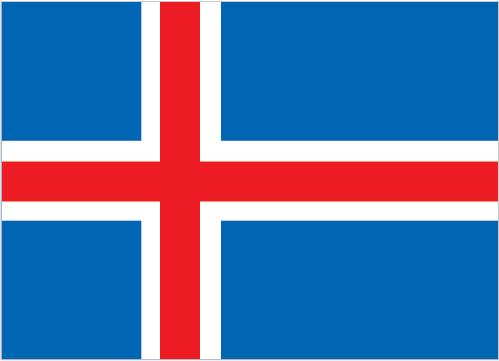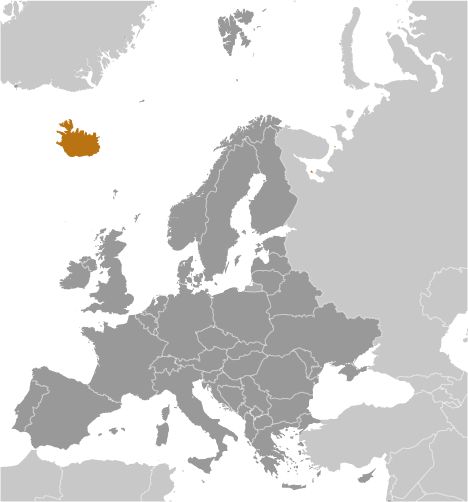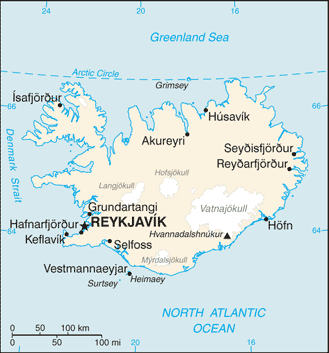|
Economy - overview:
|

|
|
Iceland's Scandinavian-type social-market economy combines a capitalist structure and free-market principles with an extensive welfare system. Prior to the 2008 crisis, Iceland had achieved high growth, low unemployment, and a remarkably even distribution of income. The economy depends heavily on the fishing industry, which provides 40% of export earnings, more than 12% of GDP, and employs 7% of the work force. It remains sensitive to declining fish stocks as well as to fluctuations in world prices for its main exports: fish and fish products, aluminum, and ferrosilicon. Iceland's economy has been diversifying into manufacturing and service industries in the last decade, particularly within the fields of software production, biotechnology, and tourism. Abundant geothermal and hydropower sources have attracted substantial foreign investment in the aluminum sector, boosted economic growth, and sparked some interest from high-tech firms looking to establish data centers using cheap green energy, although the financial crisis has put several investment projects on hold. Much of Iceland's economic growth in recent years came as the result of a boom in domestic demand following the rapid expansion of the country's financial sector. Domestic banks expanded aggressively in foreign markets, and consumers and businesses borrowed heavily in foreign currencies, following the privatization of the banking sector in the early 2000s. Worsening global financial conditions throughout 2008 resulted in a sharp depreciation of the krona vis-a-vis other major currencies. The foreign exposure of Icelandic banks, whose loans and other assets totaled more than 10 times the country's GDP, became unsustainable. Iceland's three largest banks collapsed in late 2008. The country secured over $10 billion in loans from the IMF and other countries to stabilize its currency and financial sector, and to back government guarantees for foreign deposits in Icelandic banks. GDP fell 6.8% in 2009, and unemployment peaked at 9.4% in February 2009. GDP rose 2.7% in 2012 and unemployment declined to 5.6%. Since the collapse of Iceland's financial sector, government economic priorities have included: stabilizing the krona, implementing capital controls, reducing Iceland's high budget deficit, containing inflation, addressing high household debt, restructuring the financial sector, and diversifying the economy. Three new banks were established to take over the domestic assets of the collapsed banks. Two of them have foreign majority ownership, while the State holds a majority of the shares of the third. Iceland began making payments to the UK, the Netherlands, and other claimants in late 2011 following Iceland's Supreme Court ruling that upheld 2008 emergency legislation that gives priority to depositors for compensation from failed Icelandic banks. Iceland owes British and Dutch authorities approximately $5.5 billion for compensating British and Dutch citizens who lost deposits in Icesave when parent bank Landsbanki failed in 2008. Iceland began accession negotiations with the EU in July 2010; however, public support has dropped substantially because of concern about losing control over fishing resources and in reaction to worries over the ongoing Eurozone crisis.
|
|
|
GDP (purchasing power parity):
|

|
|
$12.95 billion (2012 est.)
country comparison to the world: 146
$12.61 billion (2011 est.)
$12.24 billion (2010 est.)
note:
data are in 2012 US dollars
|
|
|
GDP (official exchange rate):
|

|
|
$13.55 billion (2012 est.)
|
|
|
GDP - real growth rate:
|

|
|
2.7% (2012 est.)
country comparison to the world: 117
3.1% (2011 est.)
-4% (2010 est.)
|
|
|
GDP - per capita (PPP):
|

|
|
$39,400 (2012 est.)
country comparison to the world: 28
$38,700 (2011 est.)
$37,900 (2010 est.)
note:
data are in 2012 US dollars
|
|
|
GDP - composition by sector:
|

|
|
agriculture: 5.3%
industry:
24.4%
services:
70.3% (2012 est.)
|
|
|
Labor force:
|

|
|
180,800 (2012 est.)
country comparison to the world: 174
|
|
|
Labor force - by occupation:
|

|
|
agriculture: 4.8%
industry:
22.2%
services:
73% (2008)
|
|
|
Unemployment rate:
|

|
|
5.6% (2012 est.)
country comparison to the world: 53
7.4% (2011 est.)
|
|
|
Population below poverty line:
|

|
|
NA%
note:
332,100 families (2011 est.)
|
|
|
Household income or consumption by percentage share:
|

|
|
lowest 10%: NA%
highest 10%:
NA%
|
|
|
Distribution of family income - Gini index:
|

|
|
28 (2006)
country comparison to the world: 123
25 (2005)
|
|
|
Investment (gross fixed):
|

|
|
14.5% of GDP (2012 est.)
country comparison to the world: 138
|
|
|
Budget:
|

|
|
revenues: $5.463 billion
expenditures:
$5.775 billion (2012 est.)
|
|
|
Taxes and other revenues:
|

|
|
40.3% of GDP (2012 est.)
country comparison to the world: 46
|
|
|
Budget surplus (+) or deficit (-):
|

|
|
-2.3% of GDP (2012 est.)
country comparison to the world: 87
|
|
|
Public debt:
|

|
|
118.9% of GDP (2012 est.)
country comparison to the world: 10
128.6% of GDP (2011 est.)
|
|
|
Inflation rate (consumer prices):
|

|
|
5.3% (2012 est.)
country comparison to the world: 148
4% (2011 est.)
|
|
|
Central bank discount rate:
|

|
|
5.4% (31 January 2012 est.)
country comparison to the world: 63
5.75% (31 December 2010 est.)
|
|
|
Commercial bank prime lending rate:
|

|
|
8.4% (31 December 2012 est.)
country comparison to the world: 120
7.7% (31 December 2011 est.)
|
|
|
Stock of narrow money:
|

|
|
$4.466 billion (31 December 2012 est.)
country comparison to the world: 104
$4.053 billion (31 December 2011 est.)
|
|
|
Stock of broad money:
|

|
|
$12.57 billion (31 December 2011 est.)
country comparison to the world: 98
$12.68 billion (31 December 2010 est.)
|
|
|
Stock of domestic credit:
|

|
|
$22.36 billion (31 December 2012 est.)
country comparison to the world: 81
$19.49 billion (31 December 2011 est.)
|
|
|
Market value of publicly traded shares:
|

|
|
$2.021 billion (31 December 2011)
country comparison to the world: 98
$1.996 billion (31 December 2010)
$1.128 billion (31 December 2009)
|
|
|
Agriculture - products:
|

|
|
potatoes, green vegetables; mutton, chicken, pork, beef, dairy products; fish
|
|
|
Industries:
|

|
|
fish processing; aluminum smelting, ferrosilicon production; geothermal power, hydropower, tourism
|
|
|
Industrial production growth rate:
|

|
|
3% (2011 est.)
country comparison to the world: 91
|
|
|
Current account balance:
|

|
|
-$700 million (2012 est.)
country comparison to the world: 105
-$953 million (2011 est.)
|
|
|
Exports:
|

|
|
$5.1 billion (2012 est.)
country comparison to the world: 111
$5.344 billion (2011 est.)
|
|
|
Exports - commodities:
|

|
|
fish and fish products 40%, aluminum, animal products, ferrosilicon, diatomite
|
|
|
Exports - partners:
|

|
|
Netherlands 32.4%, Germany 15%, UK 9%, Norway 4.4% (2011)
|
|
|
Imports:
|

|
|
$4.699 billion (2012 est.)
country comparison to the world: 131
$4.506 billion (2011 est.)
|
|
|
Imports - commodities:
|

|
|
machinery and equipment, petroleum products, foodstuffs, textiles
|
|
|
Imports - partners:
|

|
|
Norway 15.9%, US 10.8%, Germany 7.8%, Netherlands 7.3%, China 6.2%, Denmark 6.2%, Brazil 5.8%, UK 5.1% (2011)
|
|
|
Reserves of foreign exchange and gold:
|

|
|
$9.095 billion (31 December 2012 est.)
country comparison to the world: 76
$8.55 billion (31 December 2011 est.)
|
|
|
Debt - external:
|

|
|
$124.5 billion (30 June 2011)
country comparison to the world: 41
$3.073 billion (2002 est.)
|
|
|
Stock of direct foreign investment - at home:
|

|
|
$9.2 billion (31 December 2008)
|
|
|
Stock of direct foreign investment - abroad:
|

|
|
$8.8 billion (31 December 2008)
|
|
|
Exchange rates:
|

|
|
Icelandic kronur (ISK) per US dollar -
127.2 (2012 est.)
115.95 (2011 est.)
122.24 (2010 est.)
123.64 (2009)
85.619 (2008)
|
|
|
Fiscal year:
|

|
|
calendar year
|
|
|
|





 )
)



